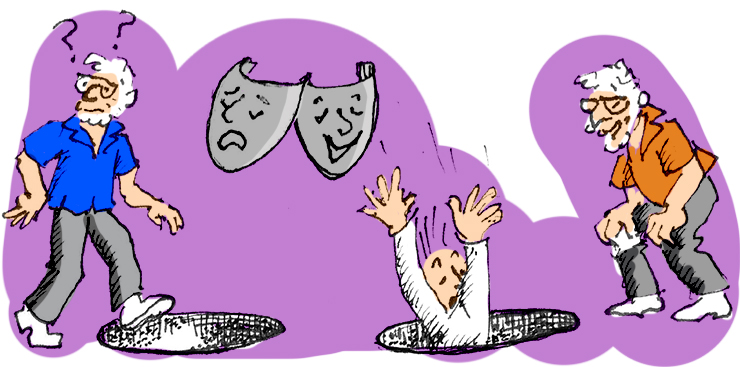
I know that some (OK—most to all) of you think that this stuff is funny, because it meets the Mel Brooks definition: “If I personally fall into an open manhole, it’s tragedy; but if somebody else does, it’s comedy;” but meanwhile, I’m the one falling into the manholes. Oy!
Anyway, this specific manhole cover began to be removed many decades ago when I met the gorgeous woman who would become my wife. She wanted a guy who could provide home-grown raspberries and peaches, and since a) she was gorgeous; and b) raspberries grow themselves, I not only became a gardener but it looked to other people like I actually knew what I was doing. Here we are 35 years later, much too late to tell them the truth.
In those Early Days of Yesteryear, we had fruit from a big patch of ‘my’ cultivated raspberries (the variety named Heritage, which are about as ‘cultivated’ as crabgrass) and a few canes of small black wild raspberries, which we discovered growing at the edge of the woods. We called them ‘black cap raspberries.’ (Other people might call them thimbleberries, but if I really cared what other people thought I would be in a different line of work…)
Beyond that, I am proud to say, I dodged the Other Fruit Issue for many years. After, all we had a strong early crop of my raspberries (always following an appetizer of the little black caps very early in the season—never more than a handful, but always welcome [I’m a handful and I wish the same could be said of me]) and a nice little run of Heritage again at the end of the season. (These late-season berries are actually the first crop; the ones in the spring are the second crop. It’s like your tomatoes getting late blight in June and then early blight in August—whoever names these things must also write the assembly directions for furniture from Ikea.)

All of this berryliciousness was/is at our permanent home (so named because I know I could never hope to clear all the junk out of the basement; I told the kids to just take the pinball machines and comic books and then torch the place). Obviously (at least to me*), peaches were not an issue early on when we lived in an apartment. (Bonsai peaches! “No; those aren’t poppy seeds, honey…”)
And I don’t think She Who Must Be Grown Fruit expected me to plant trees when we lived in a wonderful rental—where I did grow sweet corn and tomatoes (the latter*** of which are technically fruit, but don’t tell HER that or you’ll also have to sleep in the garage) (and we don’t even have one)…
Then we bought our home. Cue the Heritage raspberries. And alpine strawberries—the little flavor bombs I planted everywhere so that we could stop and go looking for buried treasures and…
(**OK—MOST things. Can we get on with this?)
(*** I just want to point out that my use of the word ‘latter’ here is pretty classy, but don’t get used to it.)
(** We have never lived anywhere that actually HAD the garage I was told to go sleep in.)

…never be on time for an appointment in the summer. And that faithful early season handful of ‘black cap’ raspberries, which I finally just decided to go out to the car to get a book to identify (and it’s cold out! And I’m tired! And cranky*!), and the author, the great Peter Del Tredici, who, like me, celebrates wild*** plants, also calls them blackcaps and thimbleberries—so there. Pffft! And I know we’re both talking about the same Rubus because he notes that “In winter the stems turn a distinctive purplish maroon,” as do mine. Heck, as do I.
But then we reached our 20th Anniversary (one more miracle and my wife gets a visit from guys with clipboards from the Vatican) and I can’t figure out what to get her; and she’s always saying “You know I like PEACHES, too,” and I’m always saying, “Yeah—I like a lot of things,” and then there’s that night in the imaginary garage, and so I ordered 10 peach trees.
Why 10? Maybe I was feeling metric. I certainly wasn’t thinking of Agatha Christie…although I did wind up being the butler in the drawing room with the candlestick—especially for Little Indians One through Four.
Our Saturn peach tree flowered the most; but no matter how many little fruits I removed (“thinned”—wouldn’t it be nice if we could do the same? “OK—take this pound off my belly and put it in the bucket, then this one…”), the darn thing never grew one full-sized peach. And then one year I just happened to be out there with a chainsaw, and you know what Chekov said (the real one, not the guy on Star Trek who couldn’t pronounce the word “Captain”)…so then there were nine. The next year, another great flowerer that never made a decent peach fell to the Russian playwright (and/or starship navigator). “Let this be a warning to the rest of you,” I enunciated loudly as the next-door neighbor walked by with her dog. “Produce or die!” Then I revved up the saw for drama and emphasis, and the resulting leg hump left the poor woman with a limp for three weeks.
(** I thought she said “charm;” I could be wrong.)
(*** invasive)
“Eight is enough.” That was a TV show, right? Maybe they meant it was too many. Cue the chain saw. ”Seven little peach trees…”
At this point it looks like the others are all producing darn nice fruits, which I credit to tough love. But I can only count six trees. Then I see one that’s been hiding behind two others all this time. Kind of my fault as I ran out of room when I first planted the things and wound up jamming three too close together in a pretty tight space, where despite the crowding, they did pretty well.
Actually two of them did ‘pretty well.’ The coward I found hiding behind Fred & Ethel turned out to just be pretty; some kind of ‘sport’ with beautiful red leaves in the summer. But pretty is for roses. Peaches are for fruit and this one never made any. And six trees are a lot less work.
Then my spare time increased by a third when two of that six died without any help from me (kind of; we’ll get to that) suddenly last summer (how Tennessee Williams of them). At about the same time, I decided to answer a question on my radio show from a listener who asked about the ‘jelly’ oozing out of his peach trees, a disturbing thing that most of mine had also done at some point but never seemed to hurt them much. So I called my Fruit Guy Lee Reich and said, “Peach tree borers—right?”
“Yes. And maybe canker, a bacterial disease that attacks trees already weakened from things like borer damage, acidic soil, and winter injury from not painting their trunks white.”
Strikes one, two, and three. (White paint?!) Then I told him about my two most recent losses and he added, “Oh; that sounds like Peach Tree Short Life, or PTSF…”
“You’re making this up.”
“No—a fair number of peach trees just wither and die suddenly, generally in their third or fourth year.”
“Mine are all 12. Or were.”
“Well then, you did great! Besides, the others are only going to be around for another two or three years, no matter what. Peach trees only live for about 15 years at best.”
“What?! Why didn‘t you tell me this 12 years ago?!”
“You wouldn’t have planted them and would have missed all this fun.”
Great. The expert I’ve been relying on for help all these years turns out to have been providing material instead. I asked: “How hard do you have to work to get peaches?”

“Are you kidding? I grow them as ornamentals. I’m happy if I get a couple of decent peaches every four or five years.”
Good thing I’ve been doing a lot better than that because we can’t afford to build a garage.
So I went out to The Petrified Forest, apologized to the dead ones and looked at the still-healthy ones with guilt, because I hadn’t yet signed them up for Medicare. Then I noticed that the multiflora rose from the woods was starting to creep a little close to The Elderly Four and decided I should try and give them the best quality of life in the Autumn of Their Years and went for the leather gloves and pruners. Cut a few canes back hard, and then, just as I was about to cut another one, realized it was a different color; more of a…a…a purplish maroon! Black cap raspberries! Glad I didn’t prune them out!
Then I saw that there were many more I hadn’t noticed because their canes arched back into the woods and away from the garden. Now I went after the multiflora with a passion, cutting it back hard and rerouting all of the purple ones I could towards the garden. We now have close to 50 canes that once were lost and now were found.
Gonna be a good spring. You know, maybe I should plant a few new peach trees…. ❖




